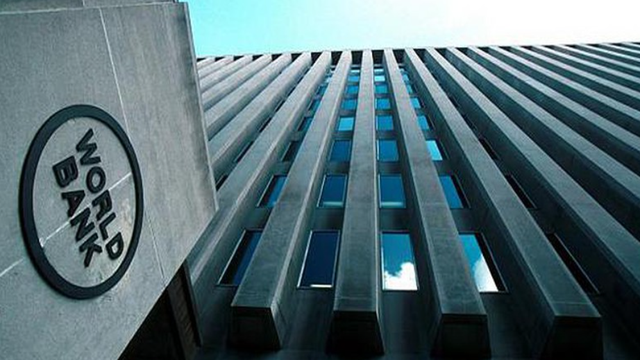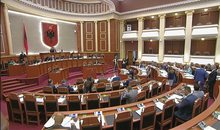
 Flash News
Flash News
Italy tightens rules for skateboard traffic
Unusual for the time, dense fog covers the coast of Vlora
Accident on the Shkodra-Lezhë axis, one dead and 3 injured
Berisha congratulates Trump on US independence: Celebration that comes after victory over the Ayatollahs' regime
Weapons trafficked from Kosovo to Albania, two arrested, 8 pistols seized
WB calls for debt transparency: Albania to publish details of every loan

The World Bank recommended radical measures and reforms to further improve transparency for the sovereign debts of countries around the world.
In the "Radical Debt Transparency" report recently published by the World Bank, upper-middle-income developing countries, including Albania, lack transparency in some segments of borrowing.
For these countries, including Albania, the report recommends a series of concrete reforms to strengthen transparency and prevent the creation of hidden or mismanaged debt. The group of countries that Albania is part of should adopt legislation that mandates detailed disclosure of loans, including contract terms and collateral.
It is required to more clearly define the definition of public debt in accordance with international standards (including public enterprise obligations and guarantees), while the use of confidentiality clauses should be limited and the signing of agreements that require total secrecy should be prohibited.
Public debt should include liabilities of state-owned enterprises, borrowings of local authorities, contingent liabilities (guarantees, PPPs, etc.).
For countries like Albania, it is required to increase the role of the Parliament and the Supreme State Audit Office in reviewing the debt strategy, approving new loans, and auditing existing contracts.
Regular audits by independent institutions are also suggested for high-risk loans (e.g., those related to natural resources or large infrastructure projects).
If a loan restructuring occurs, our country should publish the new agreed terms and avoid selective agreements.
The group of countries to which Albania belongs is required to publish a structured loan-by-loan format of each new debt agreement, with key financial terms.
It is also recommended to create an official portal on public debt where key contracts, regular analytical reports, and borrowing planning and risk assessment are published.
In 2024, public debt reached 54.74% of GDP, a decrease of 2.7 points compared to 2023. This was the lowest level of public debt in relation to GDP since 2008. The decrease in debt last year did not come due to a planned program, but from the failure to realize budget expenditures according to plan. The inability to spend led to a forced fiscal consolidation. But in the meantime, a series of liabilities from public enterprises and others are not included in the official public debt indicators./ Monitor
Latest news



Rapid developments in the Sultanates!
2025-07-04 18:00:06



Italy tightens rules for skateboard traffic
2025-07-04 17:20:18

Unusual for the time, dense fog covers the coast of Vlora
2025-07-04 16:48:01


Accident on the Shkodra-Lezhë axis, one dead and 3 injured
2025-07-04 16:14:19
Albania with fewer requests for asylum and Albanian citizenship in 2024
2025-07-04 16:06:57

Albania last for quality of life, DP: Technical government is the solution!
2025-07-04 15:42:30
Nico Williams says "No" to Barcelona, signs with Athletic Club until 2035
2025-07-04 15:33:35
Fires in the country, four fires are still active, what is the situation?
2025-07-04 15:24:20

Summer brings big changes for these 4 zodiac signs
2025-07-04 15:00:04
Osmani: MPs need to agree to a secret ballot for the Speaker of Parliament
2025-07-04 14:51:09
Serious accident on the Peqin-Elbasan axis, two injured
2025-07-04 14:37:56

GJKKO leaves in force the security measure for the head of the KPP
2025-07-04 13:58:17
Who will replace Ilir Meta and take over the leadership of the PL?
2025-07-04 13:50:36
Berisha: Dismissal of directors in Vlora, another act of 'scapegoats'
2025-07-04 13:41:46




Librazhd/ In a serious psychological state, the young man consumes pesticides
2025-07-04 13:05:07


Weapons trafficked from Kosovo to Albania, two arrested, 8 pistols seized
2025-07-04 12:33:28
Konsumimi i tepërt i çokollatës, ja cilat janë dëmet që shkakton në organizëm
2025-07-04 12:23:35

Fires in the country, 21 fires in the last 24 hours, 4 still active
2025-07-04 12:00:19
WB calls for debt transparency: Albania to publish details of every loan
2025-07-04 11:50:05
Changes in the State Police, new names expected to lead 5 police stations
2025-07-04 11:40:06

The race for the head of the BKH, the third phase on July 11
2025-07-04 11:20:23

Toxic phrases that show your relationship is in trouble
2025-07-04 11:00:10

2 brothers arrested in Roskovec, cultivating narcotic plants
2025-07-04 10:38:08

Celebrating his 61st birthday today, Rama is surprised at the pink headquarters
2025-07-04 10:21:46
Suspended from duty 4 days ago, Jonaid Myzyri appears before the Criminal Court
2025-07-04 10:16:27
Heat wave/ 5 deaths in Italy from high temperatures
2025-07-04 10:07:55
Economy slows, telecommunications joins agriculture and industry in recession
2025-07-04 09:58:13



Fire continues at Elbasan incinerator, toxic smoke endangers citizens' health
2025-07-04 09:19:06
The USA celebrates its 249th anniversary of Independence
2025-07-04 09:09:22

After Rama's ultimatum, all directors of the Vlora municipality resign
2025-07-04 08:46:30
Russia, the first country in the world to recognize the Taliban government
2025-07-04 08:37:20
10 facts about the 10th legislature!
2025-07-04 08:21:35
Foreign exchange/ How much foreign currencies are bought and sold today
2025-07-04 08:01:50

Weather forecast for today
2025-07-04 07:36:43
"Don't be afraid", here's what the stars have predicted for each sign
2025-07-04 07:21:48
Morning Post/ In 2 lines: What mattered yesterday in Albania
2025-07-04 07:03:17
Bushati: Zegjineja, a book piloted by Rama
2025-07-03 22:57:30








Greece imposes fee to visit Santorini, how many euros tourists must pay
2025-07-03 20:50:37
Don't make fun of the highlanders, Elisa!
2025-07-03 20:43:43
Gunfire in Durres, a 30-year-old man is injured
2025-07-03 20:30:52

The recount in Fier cast doubt on the integrity of the vote
2025-07-03 20:09:03




Heatwave has left at least 9 dead this week in Europe
2025-07-03 19:00:01

Oil exploitation, Bankers accused of 20-year fraud scheme
2025-07-03 18:33:52
Three drinks that make you sweat less in the summer
2025-07-03 18:19:35
What we know so far about the deaths of Diogo Jota and his brother André Silva
2025-07-03 18:01:56



Another heat wave is expected to grip Europe
2025-07-03 17:10:58

Accident on Arbri Street, car goes off the road, two injured
2025-07-03 16:45:27

Accused of two murders, England says "NO" to Ilirjan Zeqaj's extradition
2025-07-03 16:25:05





